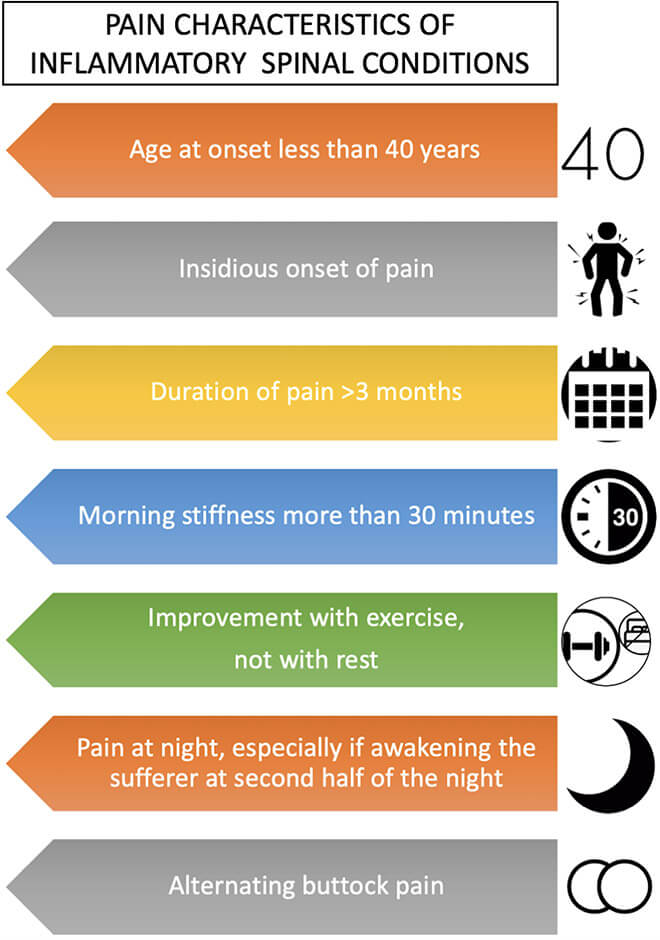If you suffer from back pain located in one or more areas of the spine (neck, mid-back, lower back or pelvis) and, particularly if your symptoms have been present permanently or intermittently for years, you might be aware of or even being diagnosed with the label “non-specific back pain”. These words indicate that no identifiable cause of pain can be found which is the case in a vast majority of patients. However, there is a group of disorders that is clearly different and that should be considered particularly if your pain has some or all of the characteristics described later in this text.
Understanding Inflammatory Spinal Disorders and Their Impact
Introduction to Inflammatory Spinal Disorders
What are Inflammatory Spinal Disorders
Inflammatory spinal disorders are a group of medical diseases sharing back pain with inflammatory characteristics and possible manifestations in other organs/systems (e.g. skin, eye, digestive system (gut), heart, and urogenital). The main components of this group of disorders are Ankylosing Spondylitis, Psoriatic Arthritis, Reactive Arthritis and Arthritis associated with Inflammatory Bowel Disease.
Prevalence and Genetic Factors
This group of diseases are in some way related to genetic factors and show a variable distribution across the world with figures of global prevalence (i.e. the percentage of a population that is affected with a particular disease at a given time) in the general population ranging from 0.2% to 1.61%. Among subjects suffering from low back pain, the overall probability of having one inflammatory disease raises to 5% (i.e. 1 person in 20).
Characteristics of Inflammatory Back Pain
Concerning the characteristics of pain, several sets of criteria have been proposed to identify the inflammatory nature of back pain. In this text, we have pooled together the main criteria included in at least one of these sets. Of note, it is not mandatory that all these characteristics be present to consider the sufferer falls into the inflammatory category.

Diagnosis of Inflammatory Spinal Diseases
Diagnostic Criteria for Inflammatory Spinal Diseases
Once the inflammatory back pain has been recognised, different sets of criteria exist to confirm the diagnosis of an Inflammatory Spinal Disease. These criteria include clinical, radiological and/or blood test characteristics.
Importance of Early Diagnosis and Advances in Treatment
Identifying such an origin and establishing a precise diagnosis is highly relevant since major advances in specific medication treatments have been accomplished. Despite several tools like the availability of blood tests and modern imaging techniques to make the diagnosis, recent studies still show an average delay of 9 years between the first symptoms and the acknowledgment of the inflammatory disease.
Treatment: Taking Action and Seeking Help for Inflammatory Spinal Disorders
When to Raise Concerns with Your Healthcare Provider
If you think that your back pain has some inflammatory characteristics and/or if you have other symptoms (skin/nail psoriasis, arthritis, tendinitis, eye inflammatory problems, gut symptoms) that might be related, you could raise the question of a possible Spondyloarthritis (generic term for this group of spinal diseases) to your health care provider to be sure that such a diagnosis has at least been considered. Such a proactive attitude from patients seems even more important if one of your relatives suffers or has been diagnosed with spondyloarthritis since family involvement is a characteristic of these illnesses.

EUROSPINE is a society of spine specialists of various disciplines with a large knowledge of spine pathologies. All well-known and accepted treatment modalities for spine pathologies are represented by the members of the society. However, the Society cannot accept any responsibility for the use of the information provided; the user and their health care professionals must retain responsibility for their health care management.